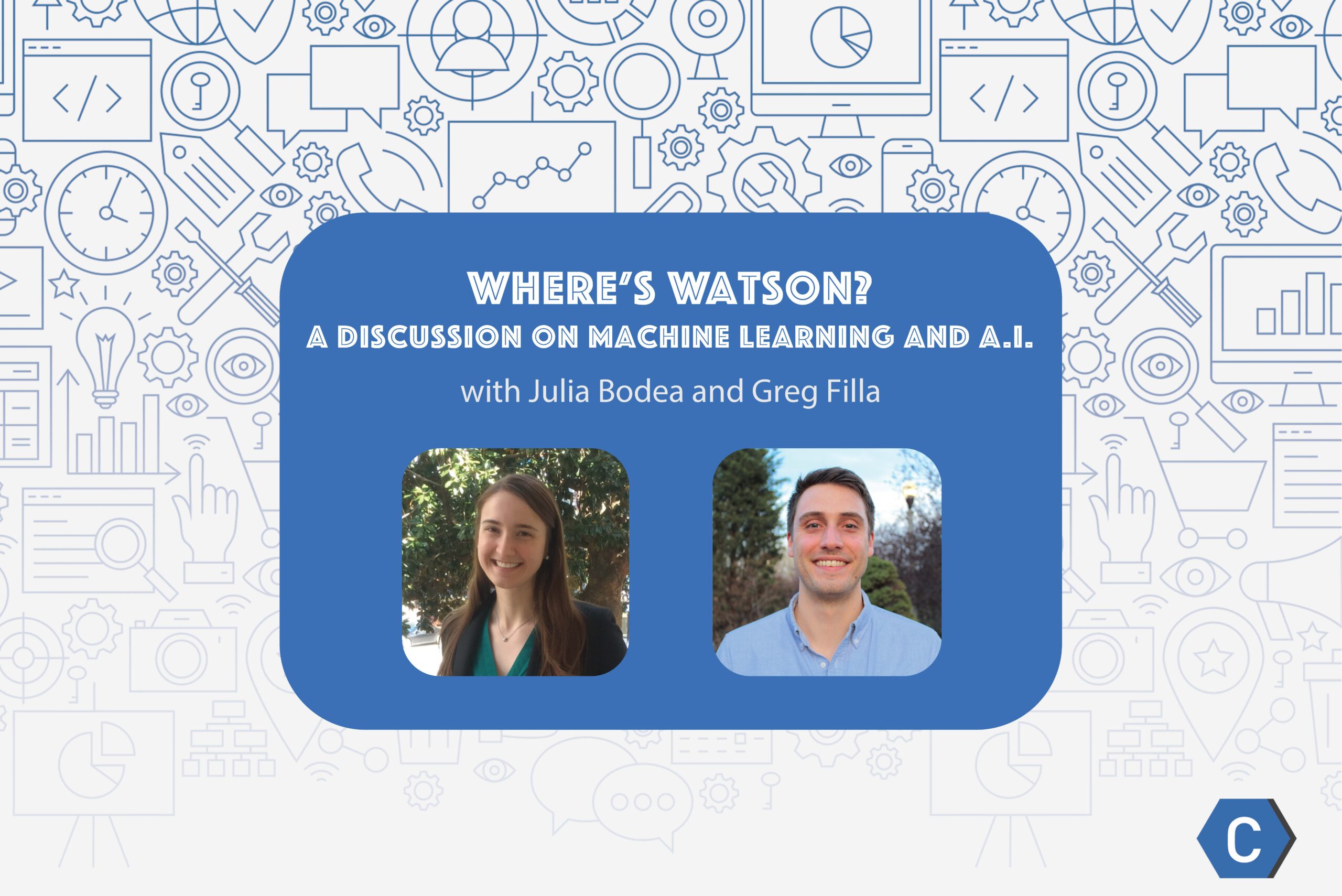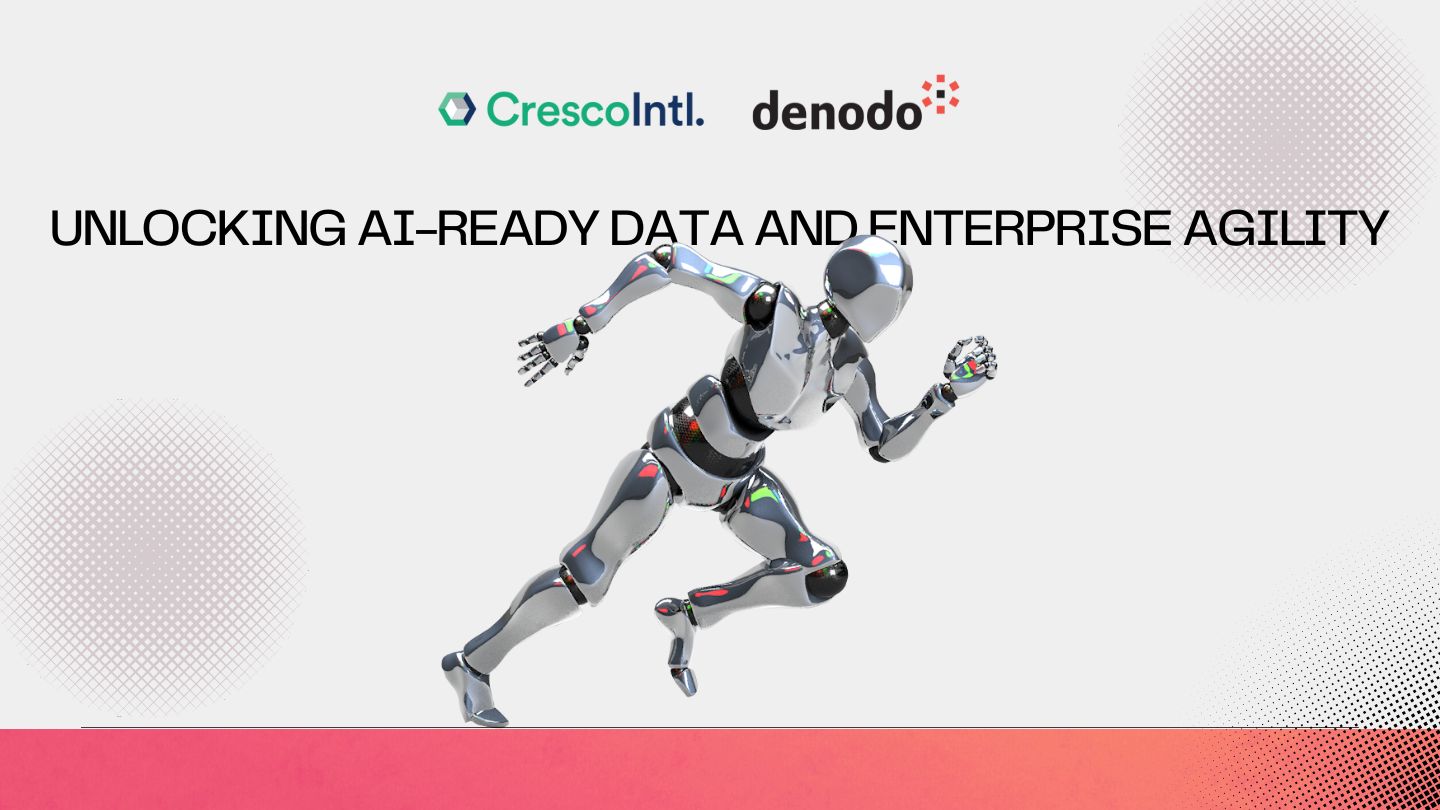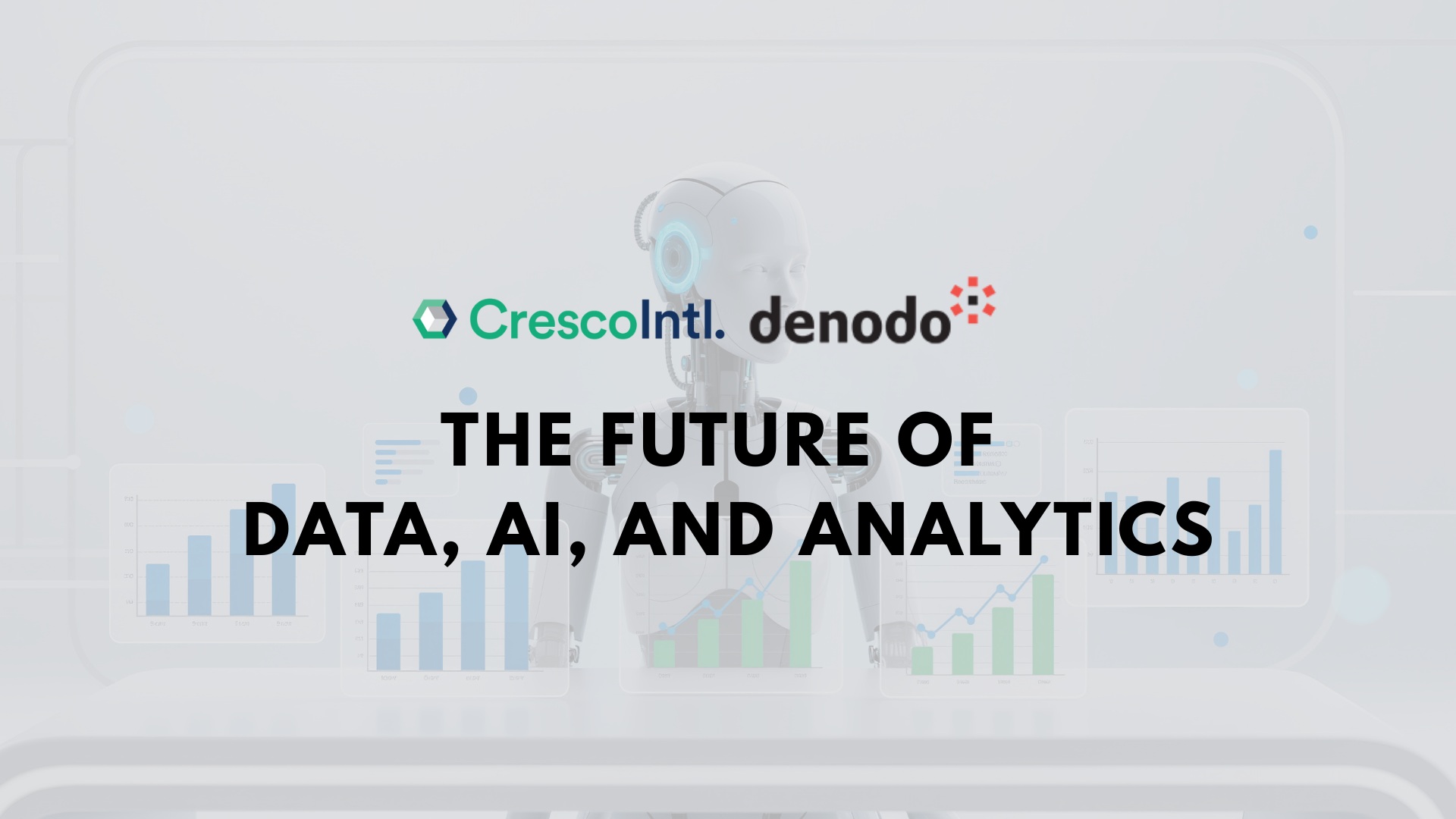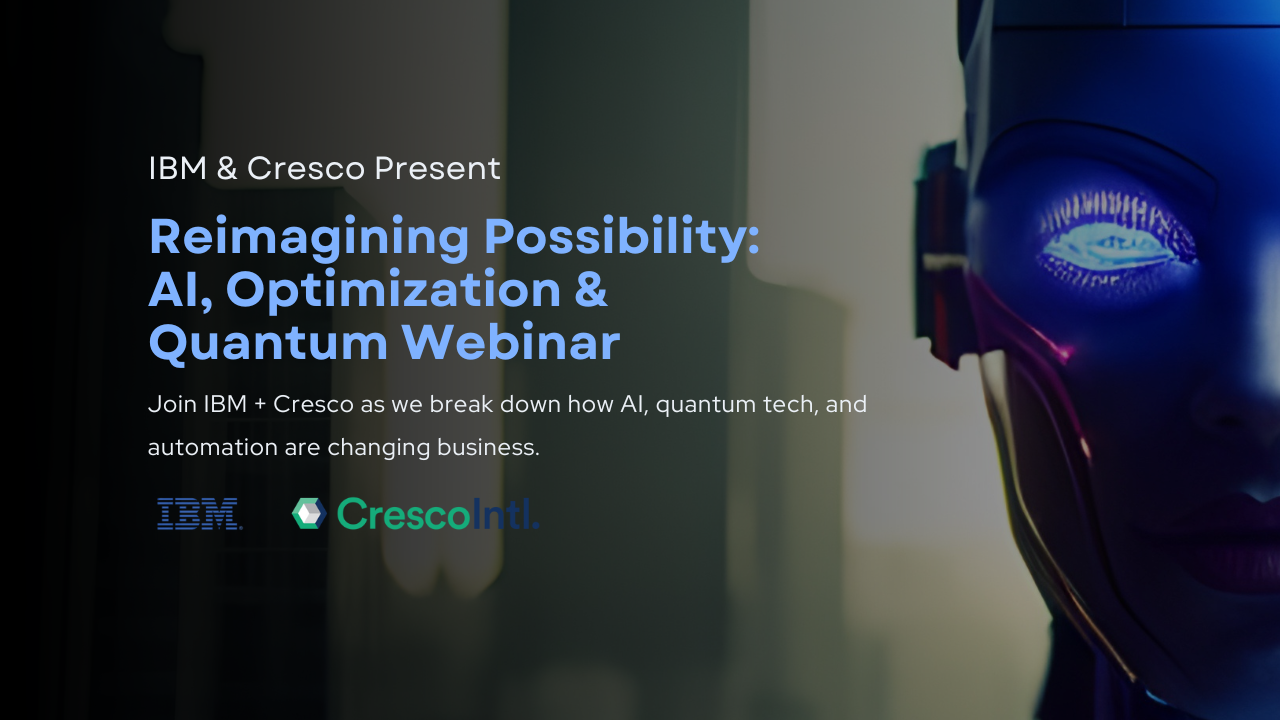What’s currently happening in the world of machine learning & AI? Join us for an insightful discussion with Watson product managers Julia Bodea and Greg Filla as we discuss where we stand today with this technology and how Watson Studio & Watson Machine Learning are changing the game.
Where’s Watson?
Amanda Buckholt (00:15):
Coming live from Dallas, Texas is Amanda from Cresco International. You know, they say everything’s bigger in Texas and that includes the stars we bring on our show here today. We have here with us Julia Bodea and Greg Filla, IBM product managers for Watson Studio and Machine Learning. Cresco’s VP of Services Kenny Mobley and Cresco’s Director of Technology Ryan Tien are here with us today to discuss AI and machine learning. We can’t wait for y’all to hear the great insights from these data science experts. I’m going to kick us off here by asking our guests to introduce themselves and give a quick overview of their backgrounds. Julia, why don’t we start with you?
Julia Bodea (00:56):
Sure. Hey guys- I’m Julia and my background is in industrial engineering from Georgia Tech in Atlanta, so kind of close to Texas area. After that I spent some time working in visual recognition and natural language processing and ultimately decided I wanted to spend more time in the fundamentals of that area, and that brought me over to more of the data science space. I’ve been here for a little while now and focusing on Watson Studio and Machine Learning.
Greg Filla (01:28):
So hi everyone. My name is Greg Filla and thanks a lot to the Cresco team for inviting Julia and me to join the podcast here today. I’m a senior offering manager for Watson Studio and Watson Machine Learning here at IBM. These are offerings for the builders of AI solutions. I’ve been here at IBM for about five years. I started off as an intern working in product management for SPSS Modeler while I was earning my degree in predictive analytics from DePaul University here in Chicago where I’m based. Since then I’ve been working on the next generation of AI tools, including Data Science Experience, Watson Studio, and Watson Machine Learning. Looking forward to the discussion today. Thanks.
Amanda Buckholt (02:11):
Alright, thank you guys for that. We’re both very excited to have you on our show. Definitely very impressive backgrounds. Kenny was going to go ahead and get us started off by asking you some questions about your thoughts on AI and trends.
Kenny Mobley (02:26):
Hello guys. Thanks again for being here. Artificial intelligence plays an increasingly prominent role in our lives, including things like Netflix recommendations and digital personal assistants. What AI trends do you see upcoming?
Greg Filla (02:43):
Yeah, thanks Kenny for the question. So for AI trends, you know, the field of AI is very exciting to watch. There’s always new innovation and trends that we see emerging. One key trend that I think is important for our discussion today is something that we’re seeing with our clients. So we see a split in how organizations approach AI; On one hand you have AI buyers – these are organizations that really want to embrace AI and they’re looking for a solution they can purchase kind of off the shelf that’ll help them solve a problem that they have. So this is kind of buying a product with AI built in. Then there’s another category of organizations that are approaching AI from a builder point of view – we call them these AI builders.They are really looking for tools or solutions that can help them effectively create their own custom models, and build their own custom AI solutions, which is great because it allows them to tackle many more use cases and challenges that they have.
Julia Bodea (03:44):
Yeah Kenny just to add onto that quickly I think the other aspect is just the world that we’re in today is adding, there’s so much data being generated all the time. Like by 2025, there’s something like 463 exabytes. It’s like we’re creating new words to come up with the amount of data we have and we need a way to understand that data and to learn from it so we can make better decisions-whether that’s business value, we’re saving hours worth of productivity, predicting disastrous events. We’ll talk more about this later, but just having to do that and being able to analyze that data, it can be truly revolutionary decisions in the same way we have in the past.
Kenny Mobley (04:19):
That’s interesting that you mention the amount of data and that new techniques are required to even go through and make sense of it. In the field of AI, do we know if this increased amount of data we’re getting has really helped improve decision-making or are we still making decisions in the same way we have in the past?
Greg Filla (04:38):
I can jump in on this one. So I think what we’ve seen with the kind of the explosion of data over recent years is that it’s really put an emphasis that enterprise or organizations need to have a solid foundation for managing and organizing that data. I did listen to the previous podcast that you did with Rob Thomas and I know that on some of that podcast there was a discussion around the AI ladder. We like to talk about the AI ladder from IBM when we are framing conversations around AI with our clients, and for those who are not familiar, there’s basically four rungs of the ladder on a organization’s journey to AI. So starting at the bottom with collect, next organize, then analyze and infuse and half of those steps that the first two points collect and organize are all about really making sense of your data. So making sure that you’re collecting the right kind of data that will be valuable for downstream kind of applications, and then being able to organize that and actually make that useful for teams. Because if you don’t have that in place, you won’t really be able to get the higher ROI from applying things like business intelligence or machine learning because you don’t have a solid foundation. So I would say definitely the explosion of data has helped things, but it’s also created some new problems and challenges that organizations are still trying to address.
Julia Bodea (05:58):
I think certainly if you’re looking for the visual segmentation or natural language processing aspect of it, when you need to teach a computer the difference between like a tree and a dog or you know, even something as rudimentary as that, the amount of images you need in order to make that happen is beyond what a typical human would need. And it’s interesting, we have a lot of conversations within IBM just about
Julia Bodea (06:20):
the cognitive computing process and how a baby learns, how a child would learn. The field is moving towards making computers think that way, and it’s a very long path still. But just the amount of data that’s needed to teach a computer something versus a person, it’s still very different between machine learning and AI.
Kenny Mobley (06:39):
That’s interesting that we’re learning how to teach computers how to learn. This leads to another question I have because there’s a lot of confusion around it, and it may be because there’s not a lot of boundaries between the two terms: what is the difference specifically between machine learning and AI?
Greg Filla (06:58):
I can start on this one. So, machine learning, if you’re unfamiliar, it is a subset of AI. So AI is kind of the broadest category of, of um, the field that includes things like machine learning, um, other kinds of rules, rules based models. Um, and it’s a much broad kind of category. Then within that you have machine learning, uh, where machine learning typically what it does is, um, will attempt to predict or classify some future outcome based on training with historic data. Um, and so, you know, within the field of machine learning you have specialties or niches like, uh, deep learning, which is one kind of branch of that. Uh, but generally, yeah, so machine learning is where we are pretty excited about because a lot of the, you know, advanced AI solutions like even that Julia was mentioning like Watson visual recognition or natural language classifier, just to name a few.
Greg Filla (07:51):
Um, these are really built around machine learning and deep learning techniques. So, um, the way that again, you know, kind of bringing this back to the AI ladder, the machine learning kind of world of activities lives in around the analyze step. Um, so would be doing this once you have your data, uh, kind of cleaned up and prepared for model building. Then once you have trained a machine learning model with your historic data, then that’s when you go to the next step, which is the model operations when you’d be deploying that and embedding that model in a, in a system or application the learning.
Kenny Mobley (08:31):
Going back to the example Julia gave earlier of teaching a computer to differentiate between a cat and a tree, would the presentation of those images to that computer be a way of machine learning?
Greg Filla (08:33):
Yeah, exactly. So that’s a great example of a machine learning task. Just to double click into that a little bit, your training data would be a selection of images with a label, so if you have a set of pictures of dogs and cats, you could have that image data coupled with the label of what was actually in the photo then using a deep learning algorithm, you would feed in that data and the labels and then train the model where the model would then learn to, you know, just based on the image data, generate the accurate label. And so then the part of machine learning where it really has a big impact and pay off is that now you can come with a brand new image that’s never been seen before by this model, and it can give you the prediction or the classification for what’s in in that image.
Kenny Mobley (09:27):
Yeah, it’s really interesting the captchas that ask a human to identify things like a street sign are actually being used to feed machine learning computers out there to help them understand as well, so it’s not just a security thing- it’s also being used to help them learn. That’s all I have on thought leadership. We’re going to turn it over to Ryan who has some specific product questions to ask.
Ryan Tian (09:41):
That’s right. Thank you, Kenny. Again, thank you Julia and Greg for those useful insights. I believe a lot of people are right now are interested in IBM’s approach to AI. So can you give us more detail about what’s happening in Watson Studio and the Watson Machine Learning?
Julia Bodea (10:08):
Yeah, absolutely. So to start and to bridge between what Greg was saying before, we’re seeing three major challenges really across in the market and across all teams, one being that enterprise data lives in a lot of different places, two, that data scientists are a scarce resource and three, deploying and monitoring AI models is really hard. So for that first one that enterprise data lives in a lot of places. This isn’t really anything new but this has been further exacerbated because clients are moving some of their data to the cloud and in many cases not just one cloud but multiple. While moving the data to the cloud might be easy, that movement is certainly increasing the chance of duplication in your data or incomplete or stale data being used, any of that kind of stuff. And one of the well known monikers in the data science community and as we were just talking with Kenny and Greg, what really relies on making these machine learning models is the data.
Julia Bodea (11:03):
If you’re putting garbage data into a model you can only get garbage out. So really important piece there. The second part is data scientists are a scarce resource. A couple of challenges there, namely one that diversity, that diversity of skills and expertise needed within a data science team. So for example, data scientists might have preferences for different open source frameworks they may want on default- R and Python. But if they’re doing natural language processing or deep learning, maybe they want PI Torture TensorFlow for big data, maybe Spark or Scala. That’s a lot of different tools for a single person to master and the time that they need to learn them and not just learn them, but of course they’re evolving, they’re changing. How do you stay current on all those tools is also a big challenge that we’re seeing as well as there’s a shortage of data scientists and data scientists itself as a term.
Julia Bodea (11:55):
It’s a pretty broad term now. It applies not only to hardcore data scientists who have that PhD in math or in computer science, but it also has brought into apply to business analysts who have that deep domain expertise, but don’t have that PhD in math or computer science. But they’re still data scientists in that they’re looking to really dive into the data. They want to find out insights from it, they want it to tell a story. And then the third challenge that we’re seeing is really that deploying and monitoring models is very difficult. It’s costly and takes a lot of time. It might require skills that most data scientists don’t have. So skills you traditionally see in software engineers or in development operations. But again, that deployment piece, it’s extremely important to be able to scale and to drive value for your model. So Watson Studio and Machine Learning, it’s part of that AI ladder that Greg talked about earlier.
Julia Bodea (12:46):
It’s part of that analyze runs, specifically Watson Studio is a mini platform really that’s helping users build those models to explore data, prepare it, develop those models. And machine learning is on the other side of actually helping users deploy their models. So running the models, model management, retraining and studio and machine learning, both, they’re really responding to those three challenges that we were talking about. So for data living in many locations, we have dozens of connectors in Watson Studio so you can connect to any database wherever your data lives with no problem, multiple deployment options to help with that. For data scientists being a scarce resource, we really believe in Studio and Machine Learning, empowering your entire organization. So not just having the best of open source with notebooks and different languages for your programmatic users. Again, for those expert data scientists, but also providing visual drag and drop modeling for more of the line of business experts.
Julia Bodea (13:42):
And we think it’s really important for those heavy data science users as well as the business analysts to come together to build the best model possible and to really leverage their different expertise and of course the deploying is difficult. Putting into production is difficult. We really believe in supporting the full end to end AI life cycle. So while you may use Watson Studio for building the model, we have seamless integration with Watson Machine Learning so you can deploy your model. And then of course for monitoring, for trust, and for transparency. How do you know that your model isn’t biased? Can you trust your model to make these critical business decisions? We have Watson open scale, so that full AI life cycle.
Ryan Tian (14:23):
Okay, good. Good to know- seems like you’ve got a whole ecosystem for the Al life cycle. So I guess my next question is in regards to users, since we see that in a lot of organizations when you talk about AI, there is a data engineer, there’s a data analyst, there is data scientists, there’s even data science application developers or the project managers. So my question is – who are tools like Watson Machine Learning and Watson Studio designed for and why do they matter?
Julia Bodea (14:56):
Yeah, that’s a great question. So again, Watson Studio, because it’s more about the building and it has tools for both the expert data scientists (so the heavy coders, machine learning experts) but also for business analysts who understand the data really deeply & have that domain expertise but perhaps have less of that coding background. So I would say again, for Studio it’s those expert data scientists. And those business analysts. And for both those user personas, we have features within Watson Studio and Machine Learning that are making modeling easier and more automated. So for example, one of the features in Watson Studio is called data refinery and it’s all about looking into your data, cleansing your data, transforming your data. There’s over a hundred built in operations, no coding required, so very easy to get started, very easy to look into your data and analyze. We also have something that Greg mentioned earlier, auto AI, that’s really minimizing skills that you need to do
Julia Bodea (15:49):
predictive modeling, simply being able to drop in a data set and then having auto AI generate a model for you. And of course there’s user oversight where you can look into it and make your own decisions. But just even having that starting point and having some models spit out with certain accuracies is extremely helpful and minimizes the time required on the WML side. So the Watson Machine Learning the deployment side, there is the handoff between an analytics team who’s training the models and the application development and operations team that need to consume the models. Because the field of model operations is developing really quickly, it’s hard to say a single job title that owns that task or a single organizational structure. We’re typically talking to machine learning engineers to application developers or deployment managers that are really focused on running the machine learning model into production. Really, we’re trying with machine learning to take away a lot of the complexity that goes into that process, to take away the complexity of the machine learning model life cycle. So the philosophy for both Studio and Machine Learning is really to allow the analytics and the operations team to focus their energy on higher value things that going to are going to have greater output, greater productivity, and be more transformational for the team rather than those minute smaller tasks.
Ryan Tian (17:09):
That’s pretty amazing that you guys can have all of the AI contributors working in the same systems and even with different levels of skills, but they all can work and contribute to the same objective. Right. I believe Kenny already talked about assumptions in regards to visual recognition, cognitive and analytics. So we know deep learning is a very hot topic today and that Watson Studio now has strong support for that. So can you give us more info about deep learning and how it’s being supported in Watson Studio?
Greg Filla (17:50):
I can jump in on this one. So as we mentioned a little bit earlier, deep learning is a very exciting field. It’s a subset of machine learning. For those who are totally new to it, deep learning uses neural networks that contain many layers. So it says where we call it deep learning as a deep neural network architecture. The reason why we’re so excited about it is because it’s been delivering state-of-the-art performance over the last 10 years or so, especially with use cases using unstructured data. What I mean by that is, you know, we’re talking about images, text, audio and video-all of those kinds of data sources can now be processed by using deep learning.
Greg Filla (18:30):
And I would say if you’re looking at Watson Studio, listening to this and maybe you haven’t tried out any of our cloud services, but you’re interested in machine learning or deep learning, the easiest way to get up and running would be to try out on IBM cloud services like Watson visual recognition, which supports that image classification or natural language classifier that can label text for you using deep learning models. The nice thing about these services is that we make them available in Watson Studio on cloud. We do have a user interface that allows you to interact with these services so you don’t have to write any code, so it’s very easy to get up and running. That’s kind of just the start of this. This is kind of a prebuilt solution if you’re more on the building side.
Greg Filla (19:14):
So if you are working with data scientists or ML engineers, we have other tools in Watson Studio that help deep learning or workflows. GPU power notebooks is a very popular way to build deep learning models that’s gonna be generally available for us and Watson Studio on cloud. If you’re unfamiliar with GPU, they’re basically an essential part of a compute stack that’s required for deep learning. If you don’t have this, that could take days or weeks. And when you do have GPU it could take hours or minutes. So it’s an order of magnitude faster to kind of speed up the training process. We also offer for even more advanced users a kind of approach to deep learning that we call deep learning as a service where it allows you to submit a model training job to our cluster of GPS, which will distribute that to give you greater performance for your experimentation, which ultimately leads to a faster time to a final model which can be taken and deployed into an application. So there’s a quick roundup of everything that we have going on in deep learning.
Ryan Tian (20:16):
Thank you for your answer – IBM has so much to offer. My next question is we can see that IBM is moving a lot towards open source in the whole AI world and we know there are different type of users. Some of them may have already started on open source, some of them might still have not started, some might be completely new. So my question is what you doing for those different users, how can they finish a transition towards open source?
Julia Bodea (20:50):
Yeah, that’s a great question. I think one of the benefits of the stack is that we truly can help you wherever you are in that data science life cycle, whichever rung you’re on the AI ladder. Our products are truly built to play nice with others. You don’t have to rip and replace anything. So if you haven’t started at all and you’re looking to accelerate, starting from model building, move to production, you can get everything. You can get Studio for building, Machine Learning for deployment, Watson Open Scale for monitoring. But if, like you said, you’ve already started with building models and open source or let’s say with SPSS Modeler or anything like that, great. No need to get rid of anything. You can automatically get started with Watson Studio to provide the framework for model building. It allows your programmers and your business analysts to collaborate in one tool.
Julia Bodea (21:37):
It’ll provide the governance if you’ve already built the models and you’re ready to deploy because again, that deploying piece is where the value is really coming in-you can just use Watson Machine Learning for model deployment, for the management, for the retraining. So again, you can connect that to whatever you currently have. If you are more advanced and you already have your models built, you’ve already deployed them and you’re more so looking to answer the question of how has that model made, where is that data coming from? Who develops the model? Is it fair? Is it explainable? That’s where you can use Watson Open Scale. So truly no matter where you are, these offerings are not meant to rip and replace what you currently have. They do play well with others and so you can start at whatever part of the lifecycle you’re at.
Ryan Tian (22:26):
Okay, great to know that. Really we can see the learning curve or the switching curve towards the open source really is kind of pretty, it’s kind of smooth and flattened. So my next question is that we see that Watson Machine Learning now is taking models from decision optimization, which is the prescriptive analysis area – what do you think about the mixed nature of prescriptive analysis and machine learning?
Greg Filla (22:56):
I can take that one. So this is a recent advancement or enhancement to Watson Machine Learning to support decision optimization models as you mentioned and exactly like you point out that we’re very excited about this because there are so many use cases that do depend on or can be improved by combining both predictive models, a machine learning model with an optimization model. Just to kind of illustrate this, how this would typically work is that when starting the process, you would have a machine learning model that could predict or classify, give some kind of output for a prediction based on your historical data. Then what you can do is take that prediction as basically a new feature, a new data point that you can feed into your optimization models. So let’s say you’re creating a schedule for your workers and you’re building an optimization model for that and you have some kind of feature that is dependent on a prediction. Let’s say it’s output or something that you’re forecasting. Well, now you can combine these two and use that prediction as a field in your optimization model to ultimately give you a better solution, overall better decisions that you’re making by using a novel data source.
Ryan Tian (24:12):
Okay, great. Great, great. We can truly see that combining those together definitely can help an enterprise boost their business a lot by finding more insights. So, we know that AI has been utilized a lot of the industries, but yet there are still huge opportunities. So I’m asking you, if you had to pick up three potential industries that may receive the most helpful boost from AI, what is your choice? This might be pretty hard question for you because there is surely a lot of options out there.
Greg Filla (24:52):
So the top three, and this is from a lot of the work that we’ve been doing, the three industries have really stood out for me and the work that I’ve been doing. So one is financial services or banking. We know that many of many banks and financial institutions are advanced today, but there still is a massive opportunity there with the data sources they have and the problems that they can really tackle with advanced AI. There still a huge opportunity there. I would say second is healthcare. So, you know, we’re seeing the crisis now. Healthcare is in desperate need of help wherever possible. I think by applying AI and really analyzing data, there is really going to be major opportunities there. And then third is manufacturing. So I would say that is one, especially looking at edge and the advancements that are coming for new techniques and machine learning, like federated learning, that’s very excited to see, you know, how manufacturing can be improved by further embracing AI.
Julia Bodea (25:53):
Greg, it’s funny-you can tell we work on the same team because those were my first two as well. I would have wholeheartedly agreed with financial services and healthcare, to echo what Greg was saying, and manufacturing as well.
Amanda Buckholt (26:11):
So those are definitely some great opportunities and I’m excited to see what happens in the future with those. But to wrap things up, I’m interested in hearing about how clients in the past have used Watson Studio and Machine Learning to solve some business problems they faced.
Julia Bodea (26:29):
Amanda, that’s a great question.To go back to Greg’s point, modeling, managing model risk for quants and financial modeling and in financial services, things like decreasing churn, creating personalized marketing campaigns- so automatically generating those next best offers, upsells, suggestions or to have better customer segmentation. Also decreasing the amount of time that a customer has to find out that they’ve been approved for a loan or not is another example we’ve seen. Greg, any others to add?
Greg Filla (27:07):
I think that’s a great summary for a lot of the popular use cases that we see.
Amanda Buckholt (27:13):
Well, thank you guys for those great examples and thank you so much for taking the time to be here with us today. We had a really great time exploring your thoughts on AI and machine learning, as well as learning more about the capabilities of Watson Studio and Machine Learning. Thank you too to all our listeners for tuning in today, join us next time as we discuss data visualizations in Cognos and make sure to follow us on LinkedIn under Cresco International to stay up to date on the latest news in the analytics world.











